Nature Conservation 2024 — 30. 5. 2024 — On Nature in the Czech Republic — Print article in pdf
Development of an Area after the Fire in the České Švýcarsko/Bohemian Switzerland National Park

Experts in a range of disciplines are currently studying the impacts of the 2022 České Švýcarsko/Bohemian Switzerland National Park fire on different ecosystem components in the fire area, and are also monitoring spontaneous natural restoration there. The present article summarises some of the first empirical observations, which can partly also be seen by visitors to the National Park, and includes several photographs comparing the situation between 2022 and 2023. Exact results of these studies will undoubtedly be the topic of scientific publications after the completion of ongoing research projects.
Introduction
For obvious reasons, the extensive fire of 2022 in the České Švýcarsko/Bohemian Switzerland National Park is given great attention. Very soon after the fire, a study titled Which Factors Influenced the Start and Spread of the Fire in the České Švýcarsko/Bohemian Switzerland NP? was made (Hruška et al. 2022, Jaké faktory ovlivnily vznik a šíření požáru v NP České Švýcarsko? (mzp.cz)), not only analysing factors influencing the speed of fire spread and fire intensity, but also putting the event in a broader historical and palaeoecological context, as it is important to know the past role of fires there and in similar sandstone areas to understand the large fires in the České Švýcarsko/Bohemian Switzerland (Jetřichovice 2006, Hřensko 2022) (see Živa 5/2023, dedicated to this topic). Similarly, the European spruce bark beetle outbreak (Ips typographus) preceding the large 2022 fire has its roots in the early 20th century, when after the Nun moth (Lymantria monacha) outbreak, Norway spruce (Picea abies) monocultures, inappropriate at this site, were planted again over a considerable area of (not only) České Švýcarsko/Bohemian Switzerland.
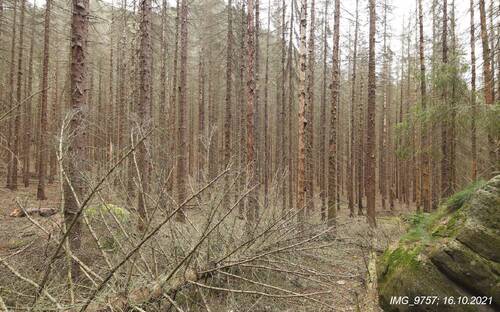
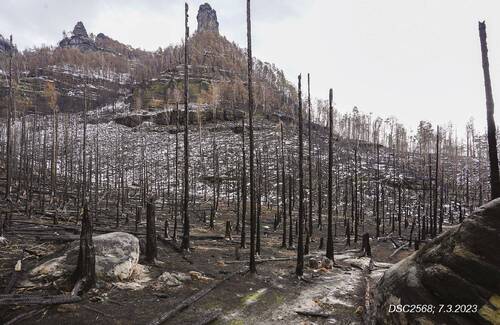
Pravčická brána/Prebischtor/Pravčice Gate, site with very high fire intensity in comparative photos one year apart (above: 2 August 2022, below: 23 July 2023). Especially the widespread occurrence of birch is conspicuous. © Václav Sojka
Fire site heterogeneity
The large 2022 fire which affected České Švýcarsko/Bohemian Switzerland over an area of more than 10 km² and partially reached the neighbouring Sächsische Schweiz/Saxon Switzerland National Park in Germany, had left behind a large area which could initially make a very uniform impression, looking like predominantly black, apparently completely lifeless, burnt land. However, already in the autumn of 2022 it became clear that the territory is considerably heterogeneous. A number of factors contributed to this diversity, primarily site differences (relief and microclimate, soil type), but also various forest types (spruce, pine, beech) which come into contact with the fire and different conditions they had been in before the fire (living, dead by bark beetle, clearings, etc.). The present state has also strongly been impacted by fire type (ground fire, crown burning) and fire intensity. The latter logically depended not only on the volume of flammable biomass available and the extinguishing intensity at a site, but was also influenced by relief shape. In valleys rising steeply and at the same time narrowing upwards, obviously a strong chimney effect occurred. That is also why exactly the fire passing through the Pravčický důl Valley had an extraordinary intensity. All mentioned drivers have created a strongly heterogeneous development in particular parts of the fire area.
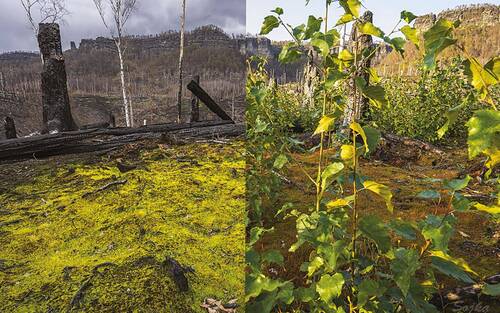
View of Mlýnská cesta /Mill Trail in the direction of the Křídelní stěna/Wing Wall. The comparative photo shows the power of forest restoration after fire. Left: March 2023, right: September 2023. © Václav Sojka
Succession and invasion
Although succession in this large area has been yet in an initial stage, a development similar to the 2006 fire site on Krkavčí skála/Raven Rock near the village of Jetřichovice can in principle be expected. While the development in most areas in early 2023 was still characterised by some pyrophilic fungi and bryophytes (typically e.g. the Bonfire moss or Common cord-moss Funaria hygrometrica), which appeared immediately after the fire, as well as by the first vascular plants, as of summer 2023 a very vigorous onset of birch occurred which will now become the dominant tree species in most of the area for many years. It cannot be ruled out that the further development will to a certain extent differ from the experience at Krkavčí skála/Raven Rock. The arrival of other tree species in the succession series, such as the European beech (Fagus sylvatica), will also depend on e.g. game numbers there. Another difference with the area at Jetřichovice may consist in the invasion rate at which the Eastern white pine, also known as the Weymouth pine (Pinus strobus) will invade the fire area. The tree was present at Krkavčí skála/Raven Rock itself as well as in its surrounding, and has still been relatively frequent. Therefore, white pines also spread in the local fire area, while it is hitherto absent from most the large fire area near the town of Hřensko.
Plant invasions in the new large fire area are now the subject of research (by the Institute of Botany of the Czech Academy of Sciences Průhonice near Prague), which should, inter alia, lead to appropriate and simultaneously realistic management measures. Even though white pine is so far not a major problem (except for the Kamenice River gorges), the new fire area is after all an ideal site for the spread of invasive alien species due to its size and the presence of a number of European spruce bark beetle clearings. To date, the American burnweed (Erechtites hieraciifolius) appears to be very successful. Being an anemogamous species, it has very fast settled the post-fire area as well as areas affected by European spruce bark beetle in the National Park. It should however be mentioned that this species has in recent years been spreading rapidly throughout the Czech Republic, and its elimination is unrealistic. Some other invasive alien species which have long been present in the NP are also spreading there, but they have now gained the opportunity for further invasion. Examples are the Canadian goldenrod (Solidago canadensis), Early goldenrod (Solidago gigantea), and the Canadian horseweed (Conyza canadensis). Other massively spreading plants are the Common foxglove (Digitalis purpurea), a European but non-native species in the region, and locally also the Common broom (Cytisus scoparius). It can however be expected that the more or less widespread invasion of birch will be a significant factor in limiting these invasive alien species.
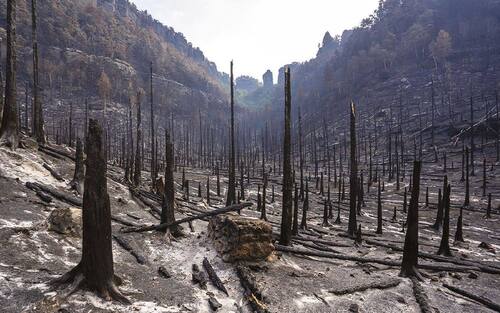
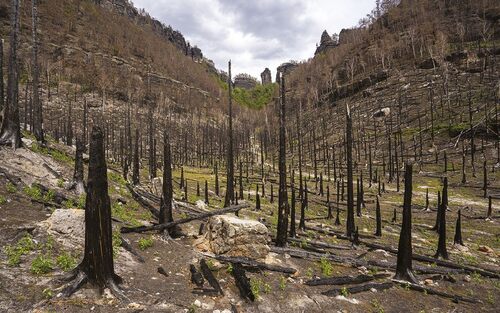
The pair of comparative photos, also from Pravčický důl/Pravčice Valley, shows however the situation before the fire (dense Norway spruce monoculture) and after the fire in spring 2023. Despite the very intensive fire, much of the wood has remained in place there. © Václav Sojka
Restoring life in the fire area under the microscope
Results regarding the fauna of the fire area have so far been based on extensive monitoring of waterlogged spruce forests affected by European spruce bark beetle (Administration of the České Švýcarsko/Bohemian Switzerland National Park and National History Museum and Gallery, Česká Lípa). Findings about the fauna of specific pyrophiles differ significantly from previous fire events. Their instant dominance in fire areas (e.g. Jetřichovice in 2006–2009) is in this case met with continuing absence (the Black fire beetle or Fire bug Melanophila acuminata) or just rare presence (ground beetle Sericoda quadripunctata). The extensive area of the present fire area is certainly an important reason for that. The already most significant results are the expansion of the Minotaur beetle (Typhaeus typhoeus) and thermophilic southern species of steppe habitats, such as the Praying mantis (Mantis religiosa) and the Golden digger wasp (Sphex funerarius).
Other important activity ongoing in the fire area include projects focused on microbiology. They are: Influence of Forest Fire Intensity on Microbial Community and Soil Microbial Processes, Importance of Management during European Spruce Bark Beetle Outbreak for Resulting Influence of Fire on Ecosystem, Soil Microorganisms and Soil Microbial Community (Institute of Microbiology of the Czech Academy of Sciences Prague), and Influence of Historical Vegetation Composition and Microclimate on After Effect of Fire on Ecosystem, Soil Microorganisms and Soil Microbial Community (group of Vladimír Hampl, Faculty of Science, Charles University Prague).
The research project Restoration of Fauna and Flora after Fire in the České Švýcarsko/Bohemian Switzerland National Park in Three Forest Types and with Different Fire Intensity, led by the Institute of Entomology, Biology Centre of the Czech Academy of Sciences České Budějovice/Budweis and supported by the Technology Agency of the Czech Republic, is oriented broadly biologically. Under the project, the positive and negative influence of fire on the biodiversity of plants, fungi, arthropods, birds, and bats is studied. At the same time, the research team is developing the topic of fire impact on the rhizobiome, its role in plant attachment, and changes in the relationship between plant and microbial community in the soil after fire.
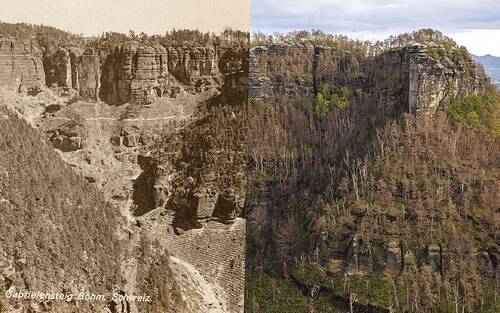
The composition of comparative photos provides a view of the plateau down to the Pravčický důl/Pravčice Valley and, opposite, the Křídelní stěna/Wing Wall. The left part of the photo is from the first half of the 20th century and shows careful afforestation (with Norway spruce) after a nun moth outbreak, whereas the right part shows the present state.
The photos evoke a sense of uselessness of historical forest management in the almost inaccessible parts of České Švýcarsko/Bohemian Switzerland. First, the original natural forests were felled, and in their place, very unstable Norway spruce monocultures were planted, which died in the early 20th century as the result of a nun moth outbreak. Then again, spruce monocultures were planted at great expense and in difficult terrain conditions, which following fell inevitably victim to a European spruce bark beetle outbreak and eventually also to a large fire in 2022. At present, secondary succession in this area is leading back to natural communities. Left: © Josef Kallasch, right: © Václav Sojka
The Czech University of Life Sciences Prague had added to this an entomological topic focusing on burnt Norway spruce stands. General knowledge of the increase in specialised stenotopic animals indicates that it takes two years after an extreme natural event before population peaks occur, which is often the best time to record them (just as in the case of ground beetle Bembidion argenteolum by the Labe/Elbe River after floods in 2002). The results of the ongoing research projects may thus potentially provide yet a range of only individually or historically confirmed species, including species new to the Czech fauna.
The research into vegetation restoration after fire in three forest types carried out by the Division of Forest Ecology, the Silva Tarouca Research Institute for Landscape and Ornamental Gardening, public research institution, Brno is also essential. Within it, the team follows up on the long-term monitoring of secondary succession in the fire area at Jetřichovice (Krkavčí skála/Raven Rock, 2006 fire), as this topic provides further context, e.g. verification of the seed bank role after fire, and a closer examination of the seed distribution after fire.
Many other larger and smaller research activities are carried out in the 2022 fire area, a complete enumeration of which would exceed the scope of this article. The monitoring of the 2006 fire area at Jetřichovice continues, too.
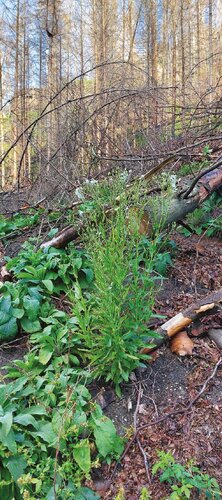
The American burnweed (Erechtites hieraciifolius) spreads vigorously in the fire area and in areas affected by European spruce bark beetle. © Handrij Härtel
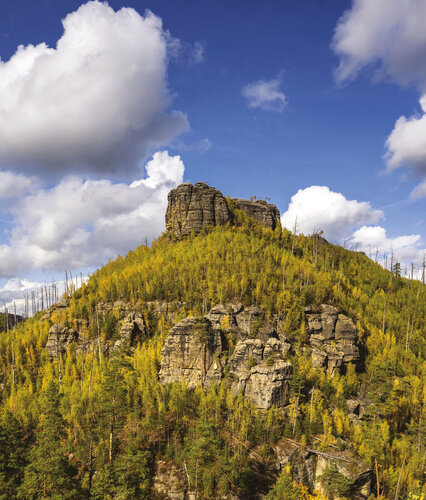
Krkavčí skála/Raven Rock at Jetřichovice, where a large fire broke out in 2006. © Václav Sojka
Impact of fire on abiotic nature
Living nature has an admirable, albeit long-lasting ability to recover after fires and similar disturbances, whereas changes following major natural events are often irreversible with abiotic nature. From a geologist's point of view, the fire affected most intensely rocks and rocky slopes above the road from the town of Hřensko to the village of Mezní Louka, the rocky slopes above the hiking trail to Pravčická brána/Prebischtor/Pravčice Gate and above Gabrielina stezka/Gabriella’s Path, as well as in the Kamenice River gorge. Rocky slopes and rocks are affected in many ways. The best visible is a peeling of the surface crust in rocky sandstones, just like the peeling of an orange or onion. This way, several centimetres of fire-blackened, mature sandstone crusts fall off, and the underlying fresh, light-coloured rock appears. Although this is less common, an entire sandstone block may crack into half due to rapid cooling during firefighting. Thus, the impact of fire on rocky slopes is extensive. Erosion on the slopes becomes stronger, leading to the loosening of small stones, but also large sandstone blocks embedded in the rocky slope and stabilised before the fire. A hidden threat is the uprooting of trees with root systems affected by subsurface fire. Especially uprooted beech trees may even cause subsequent rockfalls. For these reasons, some important České Švýcarsko/Bohemian Switzerland National Park tourist destinations have remained closed to the public (Edmundova soutěska/Edmund’s Gorge, Gabrielina stezka/Gabriella’s Path leading to Pravčická brána/Prebischtor/Pravčice Gate). ■
- - - -
Cover photo: View of area disturbed by fire and European spruce bark beetle in the České Švýcasrko/Bohemian Switzerland National Park. Foreground: the Pravčický důl/Pravčice Valley and Křídelní stěna/Wing Wall. Background: the Lužické hory/Lusatian Mts., Protected Landscape Area (PLA) and Elbe Sandstones/Labské pískovce PLA, Růžák National Nature Reserve and Vlhošť Nature Reserve in the Kokořínsko PLA (left), and České středohoří/Central Bohemian Uplands PLA (far right) - five large-size Specially Protected Areas in one view. © Václav Sojka

